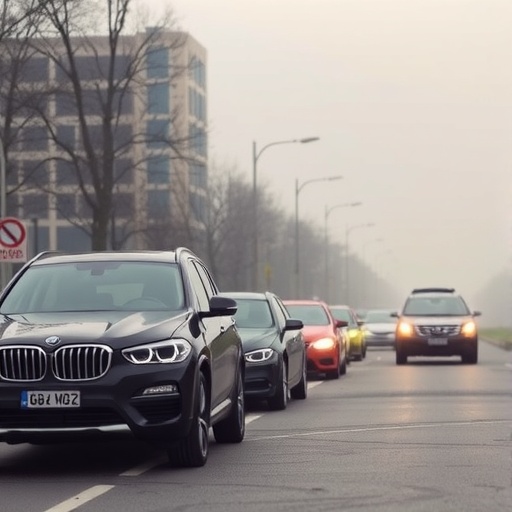A groundbreaking study from the University of Birmingham has unveiled a striking correlation between vehicle market price and harmful emissions, fundamentally challenging the conventional narrative surrounding the environmental impact of automobile ownership. Contrary to widespread assumptions that wealthier households contribute more to pollution due to higher consumption, this research finds that owners of less expensive vehicles disproportionately exacerbate urban air quality issues by driving higher-emitting cars. This revelation shines a light on an overlooked dimension of environmental inequality tied to socioeconomic status and vehicle affordability.
The study’s methodological innovation stems from its deployment of advanced remote sensing technology capable of measuring real-time emissions from over 50,000 vehicles traversing urban streets. This empirical approach allows researchers to analyze actual pollutant outputs, rather than rely solely on manufacturer-reported standards, thereby offering unprecedented accuracy in understanding the relationship between vehicle emissions and economic factors. Combining this rich emissions dataset with machine learning techniques for estimating current vehicle prices, the researchers establish a robust model linking higher vehicle prices with markedly lower emissions.
Key findings demonstrate that within identical Euro emission classes, higher-priced vehicles consistently emit substantially fewer pollutants. For example, diesel cars priced around £15,000 emit on average 5.6 grams of nitrogen oxides (NOx) per liter of diesel fuel consumed, whereas cheaper models valued at approximately £5,000 release roughly 8.8 grams per liter. This relationship underscores the insufficiency of emissions regulatory standards alone in differentiating real-world vehicle performance, emphasizing the critical role of vehicle price as a proxy for emission efficacy.
Interestingly, diesel-powered vehicles exhibit a more pronounced reduction in emissions per incremental £1,000 increase in price than their petrol counterparts. Each additional thousand pounds spent on a diesel automobile correlates with a decrease of about 0.4 grams of nitrogen dioxide (NO₂) emissions per liter of fuel. Older diesel vehicles adhering to Euro 5 standards reveal an even steeper gradient in emissions improvements with rising price, suggesting a stronger linkage between vehicle value and environmental performance in legacy models compared to contemporary Euro 6 vehicles.
These insights illuminate the complex dynamics where financial capability shapes environmental outcomes, exposing a form of environmental injustice that demands urgent policy attention. Lower-income individuals, often constrained to purchase older, more affordable, and consequently higher-polluting cars, inadvertently contribute disproportionally to urban air pollution. This exacerbates health disparities, as communities with limited economic means endure elevated exposure to pollutants such as NOx, carbon monoxide (CO), and particulate matter (PM), which are linked to respiratory and cardiovascular illnesses.
The implications of this research extend beyond mere academic interest, presenting a compelling case for reimagining transport policy through a socioeconomic lens. Progressive taxation measures that align levies with both vehicle emissions and market price could incentivize the gradual shift toward cleaner vehicles. Additionally, targeted rebate programs and scrappage incentives tailored for lower-income demographics may democratize access to environmentally friendlier transportation options, thereby mitigating emission disparities.
Moreover, the study emphasizes the importance of enhanced inspection and maintenance regimes for aging vehicles as a pragmatic, cost-effective strategy for near-term emission reductions. By mandating rigorous checks and upkeep of older, higher-polluting cars, policymakers can achieve meaningful improvements in air quality while longer-term transitions to cleaner technologies take effect. Such multifaceted approaches are vital to addressing the intertwined challenges of environmental health and social equity.
Co-author Professor Francis Pope highlights the broader societal significance of these findings, noting that vehicle price emerges as an unexpectedly powerful indicator of emission behavior. This understanding compels a reevaluation of the relationship between economic status and environmental impact, underscoring how financial capacity directly influences air quality at a local scale. It also accentuates the need for integrated analytical frameworks combining socioeconomic and environmental data to craft policies that are both effective and just.
Dr. Omid Ghaffarpasand further stresses that existing disparities in vehicle affordability perpetuate environmental injustice, disproportionately burdening disadvantaged urban neighborhoods with heightened pollution and consequent health risks. Addressing these inequalities is essential in formulating equitable transport policies that safeguard vulnerable populations while advancing sustainability goals.
This research contributes to a growing body of knowledge championed by the WM-Air consortium, which synergizes environmental science, policy, and economic development efforts at regional levels. Prior investigations by WM-Air have elucidated the significant contributions of domestic woodburning to particulate pollution and quantified the public health toll from air pollution in the West Midlands, evidencing the consortium’s instrumental role in influencing evidence-based interventions.
Looking forward, the researchers advocate for comprehensive studies that explore the interdependence of vehicle affordability, emissions profiles, and urban planning. Such interdisciplinary analyses are critical for unraveling the multifaceted drivers of urban air pollution and designing holistic solutions that harmonize environmental sustainability with social justice imperatives. The integration of socioeconomic insights into transport and environmental governance frameworks is pivotal for ensuring that policy reforms benefit broader segments of society rather than entrenching existing inequities.
In conclusion, this pioneering investigation disrupts prevailing assumptions by revealing that lower-priced vehicles substantially undermine urban air quality through elevated emissions, particularly among diesel models. It signals an urgent call to arms for policymakers and stakeholders to implement nuanced, equity-driven interventions that reconcile environmental and social priorities. Only through targeted fiscal mechanisms, support schemes, and enhanced regulatory oversight can societies hope to redress environmental inequalities and forge a cleaner, more inclusive future for urban mobility.
Subject of Research: Not applicable
Article Title: Air Pollution Emissions from Vehicles as a Function of Their Current Real World Market Price
News Publication Date: 14-Nov-2025
Web References:
Keywords: Pollution, Air quality, Automotive engineering, Transportation, Vehicles, Environmental policy, Air pollution




